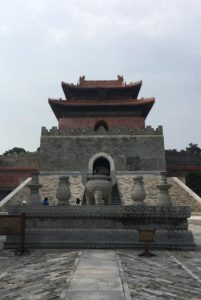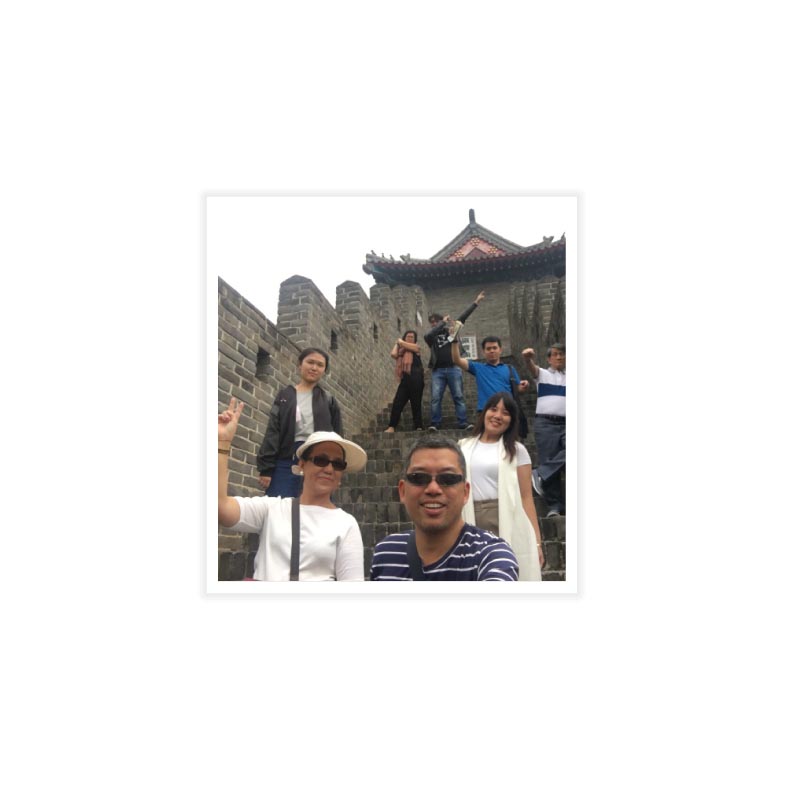
Though visiting Dezhou City to commemorate the 600th year of Sultan Paduka Batara’s trip to China is the main reason Kaisa made a pilgrimage to China, an extended stay at the Chinese capital to explore its cultural offerings proved irresistible for some. Our motley group consisted of both first-timers and repeat visitors, so coming up with an itinerary that satisfied everyone’s interests proved an easy challenge. As Beijing was a former imperial capital, its major attraction sites are invariably linked to China’s imperial past, notably the Ming and Qing dynasties.
Our Kaisa group first headed to the political heart of the city, Tiananmen Square, before trooping to the former imperial palace, more popularly known as the Forbidden City. Building of this 9,000-room palatial residence started in 1406, and 24 Ming and Qing emperors ruled from the Forbidden City.
While most of the first timers in our group proceeded to the three main halls (which included the former throne room), this writer took a slightly different route and headed to the lesser known but equally fascinating imperial side chambers to view some of the museum’s imperial ware collection.
The difference is noticeably palpable: there are less people and, in many instances, there is a quiet corner where one can take in all the imperial splendor by yourself. It is interesting to note that the builder of the palace, Ming Emperor Yong Le, is the same emperor that Sulu Sultan Paduka Batara paid tribute to in 1417. Of course, the sultan might not have seen the palace as it is today, as it was only finished in 1420.
After our tour of the imperial palace, our group enjoyed a quick lunch at Beijing’s famous Quan Ju De Roast Duck restaurant, after which we proceeded to what I would consider as one of the highlights of the Beijing leg: a visit to the famous Peking University.
Our group was warmly welcomed by the students, volunteers and faculty of the university’s Philippine Studies Program, all resplendent in their traditional barong tagalog attire.
They gave a brief tour of the branch library of the School of Foreign Languages before proceeding for a simple welcome ceremony, which included an overview of the school’s Philippines Studies Program as well as exchanging of books and tokens. We then took a leisurely walking tour of the campus.
As we made our way to school cafeteria, amid the leafy lanes, lovely lakes and beautiful Chinese-inspired school buildings, our Kaisa group interacted with the young student volunteers. Dinner was equally engaging with the presence of our country’s envoy to China, Ambassador Chito Santa Romana, who came with NBC Beijing Bureau chief Eric Baculinao in tow.
Both are old China hands and considered experts of mainland Chinese affairs. This afternoon at Peking University was as meaningful as it was memorable. It made me appreciate more the role of Kaisa as a bridge-builder not just within our country but across the seas as well.
A day-tour outside Beijing would usually involve a visit to the (very touristy) Great Wall’s Badaling section, paired off with the Imperial Ming Tombs tour. Having seen the former, I suggested visiting a lesser known section of the Great Wall at Huang Ya Guan Pass in Hebei province.
While the trip involved double the time it took to the Badaling section, it gave the group more opportunities to appreciate the scenic Chinese countryside. The three-hour drive turned out to be worth it as this section was devoid of the tourist hordes that one usually encounters in Badaling. We had most of the stretches practically all to ourselves and didn’t have to worry about photo bombers in our selfie shots!
Surprisingly, the most senior member in our group, Kaisa Davao’s Angie Angliongto, was the most gung-ho to climb and was able to reach three steep towers, quite a feat for an 81-year-old!

Equally memorable was our group’s visit the tombs of the eastern section of Qing imperial tombs. Though not as popular as the Ming tombs near Beijing, this site is just as fascinating as the final resting places of the emperors of China’s last dynasty.
We visited the major tombs that included Emperor Qian Long (1711-1799) who is considered one of the Qing Dynasty’s greatest rulers. A a patron of the arts, the tomb reflected the emperor’s sense of aesthetics with magnificent halls and elaborate stone carvings throughout the triple vaulted interior. Nearby, the tomb of Empress Dowager Cixi is just as grand on the outside, but its single-vaulted tomb is simpler affair. Still, this does not diminish the weight of this infamous character who played a huge role in the eventual downfall of China’s last imperial dynasty in 1911.
Our last day was spent within the city, where we visited the more than a century-old Beijing zoo and met its most famous occupants: the pandas! The animals came out in full-force to do their daily routine of feeding and resting, oblivious to the thousands of giggling tourists and their camera-phones.
We also made a stop at the old Summer Palace (圓明園 Yuan Ming Yuan). Not to be confused with the more popular new Summer Palace (頤和園 Yi He Yuan), this once sprawling imperial garden was destroyed by Anglo-French forces in 1860 and became a symbol of the Qing Dynasty’s weakness against foreign Western powers. The preserved ruins of the European-inspired palaces (西洋楼 Xi Yang Lou) bear testament to this cultural atrocity inflicted upon the Qing royal court by Western powers.
We capped off the day with an obligatory stop at the Temple of Heaven (天壇) where the sudden autumn breeze set the perfect atmosphere to admire what could easily be Beijing’s most handsome structure. It is here, since 1406, that the Chinese emperor would come to pray for a bountiful harvest for the empire. Amidst all the imperial splendor, we paused and, for a moment, imagined we were part of Sultan Padaka’s entourage that made the epic journey to Peking 600 years ago.





